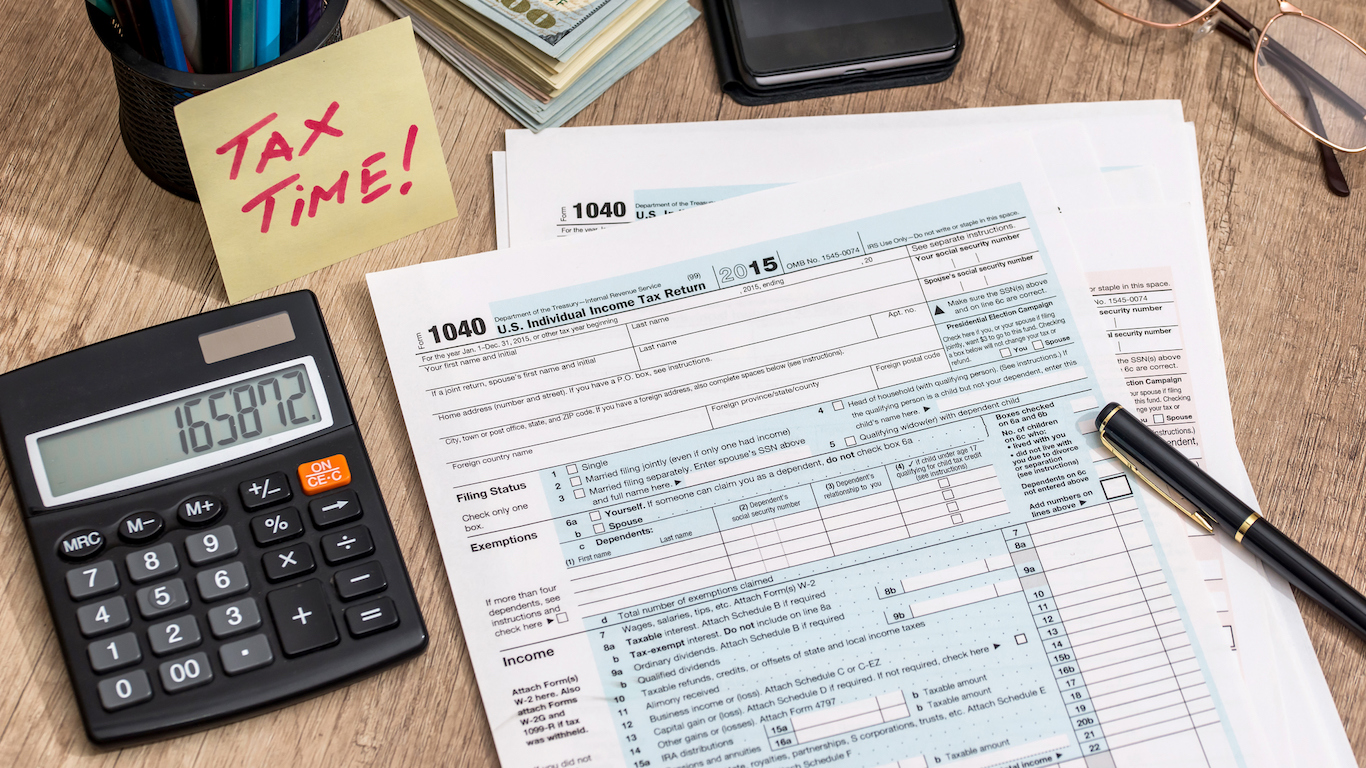Special Report
19 Mistakes the IRS Says Filers Must Avoid

Published:
Last Updated:

Tax season began on January 23, but millions of Americans have likely put off filing until the last few weeks before the April 18 deadline.
Government cutbacks last year resulted in a number of layoffs at the IRS. Likely as a result, the number of income tax audits fell in 2016 for the sixth straight year. Still, about 1 million people were audited last year. This does not include filers who had their returns sent back to be corrected — often for extremely simple and preventable reasons.
[in-text-ad]
On its website, the IRS lists several common errors filers make each year. The errors vary in complexity from failing to correctly calculate a deduction on a 1090A form to simply failing to sign and date the return or even using the wrong postage. While some of these mistakes seem obvious and easily avoidable, they are common enough that the IRS lists them as issues.
Click here to see the 19 most common tax mistakes.
A great many of these errors can be avoided simply by filing electronically, as most Americans now do. The number and share of Americans filing electronically rose from 68.5 million, or about 51%, in 2005 to 128.8 million, or 91%, in 2015. Still, filing through a software such as turbotax, or using a service that e-files for you, can be expensive, and some prefer the sense of control that filing by hand can provide. Electronic filing also can also prevent filers from including written explanations for certain deductions.
Even when e-filing, many of these mistakes still remain common. Many of these can be lumped into the category of, simply, failing to fill in the right boxes or the correct figures, or forgetting to include the various deductions, credits, and allowances.
These are the 19 most common tax mistakes.

19. Failure to make a copy of signed return
It is important to make a copy of signed tax returns as many common types of loans, including mortgages and student loans, require past tax information. If filers are missing copies of previous returns but need one, the IRS can send a copy, the IRS can send you a copy for a $50 fee per tax year.
[in-text-ad]

18. Failure to double-check routing and account numbers
While this may seem obvious, it is one of the more common mistakes. Banking and routing numbers with errors can make it difficult for the IRS to deposit refunds owed.

17. Failure to include all necessary information on checks or money orders
If filers owe the IRS money, they must include a payment — check or money order payable to the “United States Treasury” — that includes name, address, social security number, daytime telephone number, tax form, and the tax year on the payment.

16. Sending in return with inadequate postage
If you are not one of the many Americans who file their taxes electronically, make sure you have the correct postage on the envelope when you send in your taxes. Otherwise, the postal service will return it to you, putting you at risk of missing the April 18 deadline.
[in-text-ad-2]

15. Sending your return to the wrong IRS office
There are different IRS office addresses for specific regions and types of tax documents. If you send your return to the wrong IRS office, potentially delaying your refund, you are not alone. Using the wrong address is one of the most common mistakes Americans make each year.

14. Arranging tax documents in the incorrect order
Errors on your tax return, including something as simple as failure to organize documents in sequential order, can result in a delayed refund.
[in-text-ad]

13. Failing to attach 1099-R forms
1099-R forms are used to claim retirement plans, pensions, and annuities withheld over the course of the year, or when funds are withdrawn from an IRA. Some of these funds can be treated as income, bumping filers into a higher bracket. Failing to report these payments can result in an audit.

12. Failure to include all W-2 forms
The IRS requires taxpayers to include an official copy of their W-2 from their employer or employers, if they have more than one job. Wages and withholdings noted on these forms must be combined and reported on the tax return.

11. Failure to use Identity Protection PIN (if applicable)
An IP PIN is a six-digit number assigned to eligible taxpayers to help protect against fraudulent use of their social security number. Eligible IP PIN taxpayers include those who were invited by the IRS and those who filed a tax return with an address in Florida, Georgia, and the District of Columbia last year. While not everyone has been issued an IP PIN, those who have must follow separate tax filing instructions specific to IP PIN holders.
[in-text-ad-2]

10. Failing to sign and date return
One of the simplest and most important steps while filing is signing and dating the return, and have your spouse sign and date if you are filing jointly. Unsigned and undated returns cannot be accepted and will be sent back for signing.

9. Using incorrect column from the tax tables form
If you are calculating your own taxes, you will likely need to refer to the 1040 Tax Tables document to make the calculations. If you are not looking in the column applicable to to you, however, you will inevitably miscalculate. While this may sound obvious, the IRS reports it as one of the most common mistakes.
[in-text-ad]

8. Failing to claim the correct deduction if over 65 or blind
If you or your spouse are blind or at least 65, you can claim it as a deduction. But filers must use a chart found on the 1040 or 1040A form to determine the correct deduction. According to the IRS, people claiming this deduction frequently misuse the tables and list the wrong amount.

7. Failure to enclose negative amounts in brackets
This common mistake can have potentially serious consequences. If negative figures are not noted in brackets, they may be misinterpreted by the IRS as positive numbers and result in additional taxes.

6. Incorrectly calculating deductions and credits
Tax deductions, such as charitable donations effectively reduce taxable income, while tax credits directly reduce taxes owed. Miscalculations could result in overpaying the IRS.
[in-text-ad-2]

5. Entering income on the wrong lines
One simple and easily avoidable mistake that will certainly raise eyebrows at the IRS is income entered in the wrong boxes.

4. Failure to correctly list all dependents
Taxpayers must list all names and taxpayer identification numbers for each person listed on the return. If the tax filer is using social security numbers, the corresponding names must appear exactly as they do on the corresponding social security card.
[in-text-ad]

3. Failure to correctly declare exemptions
In order to benefit from spousal and dependency exemptions, the IRS requires certain information. For spousal exemptions, both you and your spouse’s age as well as their gross income amounts must appear. For dependents, taxpayers must disclose their relationship to the dependent and the amount of support provided.

2. Choosing the incorrect filing status
Filing status is used to determine certain filing requirements, deductions, and credit eligibility. Despite being essential to correctly filing taxes, choosing the incorrect filing status remains a relatively common mistake among American taxpayers.

1. Tax return is illegible
It should come as no surprise that if the IRS cannot read your name, taxpayer ID number, or address, agents cannot process your return. Still, illegible penmanship is a common problem among those who do not file electronically.
Choosing the right (or wrong) time to claim Social Security can dramatically change your retirement. So, before making one of the biggest decisions of your financial life, it’s a smart idea to get an extra set of eyes on your complete financial situation.
A financial advisor can help you decide the right Social Security option for you and your family. Finding a qualified financial advisor doesn’t have to be hard. SmartAsset’s free tool matches you with up to three financial advisors who serve your area, and you can interview your advisor matches at no cost to decide which one is right for you.
Click here to match with up to 3 financial pros who would be excited to help you optimize your Social Security outcomes.
Have questions about retirement or personal finance? Email us at [email protected]!
By emailing your questions to 24/7 Wall St., you agree to have them published anonymously on a673b.bigscoots-temp.com.
By submitting your story, you understand and agree that we may use your story, or versions of it, in all media and platforms, including via third parties.
Thank you for reading! Have some feedback for us?
Contact the 24/7 Wall St. editorial team.